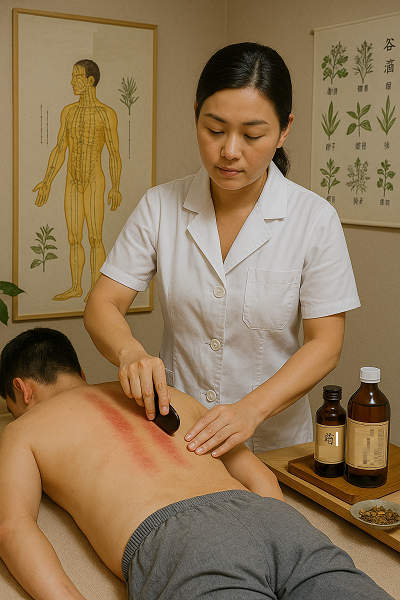Is Gua Sha Effective in Treating Chronic Prostatitis?
Chronic prostatitis is a common urological condition in men that has long troubled countless patients. In the pursuit of effective treatments, many have explored various options, including Gua Sha, a traditional Chinese therapy that has attracted growing attention. But does Gua Sha really help with chronic prostatitis? Let's take a closer look.

The Basic Principles of Gua Sha in Treating Chronic Prostatitis
Gua Sha is a traditional therapy in Chinese medicine that involves repeatedly scraping the skin with a special instrument to stimulate circulation, unblock meridians, and regulate internal organ functions. When it comes to treating chronic prostatitis, Gua Sha works in several key ways:
Unblocking Meridians: According to Traditional Chinese Medicine (TCM), meridians are pathways for the flow of Qi and blood. In prostatitis, these pathways are often blocked. Gua Sha helps stimulate meridians, enhance blood flow, and improve circulation around the prostate, potentially easing inflammation.
Promoting Blood Circulation and Resolving Stagnation: Chronic inflammation of the prostate often leads to poor blood flow and congestion. Gua Sha can promote the dispersion of blood stasis, reduce swelling and pain, and improve overall prostate function.
Regulating Organ Function: In TCM, the prostate is closely related to the kidneys and bladder. Gua Sha helps regulate the function of these organs, boost the immune system, and enhance the body's ability to fight chronic prostatitis.
Key Benefits of Gua Sha for Chronic Prostatitis
Here are several potential benefits Gua Sha may offer in managing chronic prostatitis:
Improves Local Circulation: By stimulating specific acupoints near the prostate, Gua Sha promotes better blood and lymphatic flow, helping to reduce inflammation and improve tissue repair.
Accelerates Inflammation Resolution: Gua Sha enhances local metabolism, promoting the removal of inflammatory substances. It stimulates nerve endings in the skin, thereby facilitating the body's natural healing process.
Boosts Immunity: Scraping the skin can activate immune cells, helping the body better resist infection and inflammation.
Alleviates Pain and Discomfort: Gua Sha encourages the release of natural pain-relieving substances such as endorphins. For chronic prostatitis sufferers, this can help ease perineal, lower back, or pelvic pain, improving overall quality of life.
How Gua Sha Is Applied for Chronic Prostatitis
Gua Sha treatment for prostatitis generally includes two approaches: systemic Gua Sha and localized Gua Sha.
Systemic Gua Sha
This method involves scraping along the spine and other key acupoints like Dazhui (GV14), Fengchi (GB20), and Jianjing (GB21) on the upper back, which help clear internal heat and toxins. Additional points on the abdomen such as Ganshu (BL18), Danshu (BL19), Guanyuan (CV4), and Shenque (CV8) may be targeted to alleviate lower abdominal pain and bloating associated with prostatitis.
Localized Gua Sha
This technique focuses on acupoints near the prostate region to directly target inflammation. It includes the following acupoints:
- Points Used: Shenshu (BL23), Pangguangshu (BL28), Qihai (CV6), Zhongji (CV3), Yinlingquan (SP9), Sanyinjiao (SP6), and Dadun (LV1).
- Treatment Method: Use scraping and pressing methods. First scrape Shenshu and Pangguangshu, then press Qihai and Zhongji. Finally, scrape Yinlingquan, Sanyinjiao, and Dadun. The intensity should be tailored to the patient's condition.
Important Note: After Gua Sha, it is crucial to keep the treated area warm, clean, and dry. Avoid cold exposure, hot showers, or vigorous physical activity for at least 24 hours post-treatment.
Is Gua Sha Truly Effective for Chronic Prostatitis?
So far, there is no definitive scientific consensus on the effectiveness of Gua Sha for chronic prostatitis. However, small-scale studies and clinical observations suggest that it can provide supportive relief for some patients, depending on several factors:
Individual Response: Some individuals may notice a marked improvement, while others may experience little change.
Type of Prostatitis: The efficacy of Gua Sha may vary depending on the underlying cause and type of prostatitis.
Timing: Gua Sha may be more beneficial during the early stages of the disease.
The Importance of an Integrated Treatment Approach
Given the variable effectiveness of Gua Sha, an integrated treatment approach is recommended for chronic prostatitis. This may include:
Medication: Depending on the patient's condition, options may include antibiotics, anti-inflammatory drugs, alpha-blockers, or herbal remedies. Many patients have reported positive outcomes with Diuretic and Anti-inflammatory Pill, a traditional Chinese formula developed by Dr. Lee's TCM Clinic, known for relieving urinary discomfort, improving circulation, and reducing inflammation without significant side effects.
Physical Therapies: Such as warm sitz baths, infrared therapy, and microwave therapy, which help improve blood flow and promote healing in the prostate area.
Lifestyle Adjustments: Avoid prolonged sitting, maintain regular exercise, get enough rest, and eliminate alcohol and tobacco use. These habits can significantly reduce flare-ups and support recovery.
Psychological Support: Many chronic prostatitis patients suffer from anxiety or depression. Counseling or stress-relief practices can enhance emotional well-being and support overall recovery.
Final Thoughts
Gua Sha, as a traditional Chinese therapy, may provide certain benefits for chronic prostatitis when used appropriately. However, it should not be viewed as a standalone cure. A personalized, holistic treatment plan—combining herbal medicine like Diuretic and Anti-inflammatory Pill, physical therapy, and lifestyle changes—offers the best path toward effective and lasting relief.



